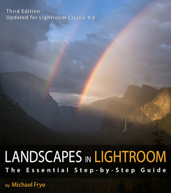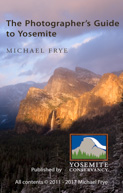In the Moment:
Michael Frye's Landscape Photography Blog
by Michael Frye | Oct 30, 2025 | Light and Weather, Travels and Stories

Dappled light at a canyon overlook, Utah
Claudia and I are finally on our way home after our long road trip. It’s been a fantastic journey, and we really don’t want it to end, but we’ll be back on the road again soon, heading to the Oregon Coast. That’s one of my favorite places to photograph, so I’m looking forward to that already.
I’ve made lots of new images on this trip that I’m excited about. It’ll take some time to sort through and process them all, but here are a few photos from one stormy day in Utah.
(more…)
by Michael Frye | Oct 19, 2025 | Travels and Stories
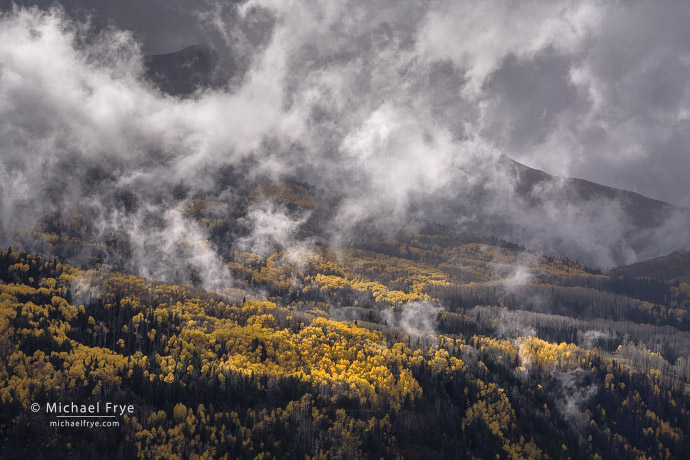
Clouds, mist, and aspens, Colorado
After returning from Greenland, Claudia and I spent only a few days at home before starting a road trip to Utah and Colorado. We began by photographing autumn aspens and maples in the Wasatch Mountains of Utah, then moved to western Colorado for more aspens. Now we’re back in Utah, but in the southern part, with red-rock deserts and yellow cottonwood trees. We’re having a great time.
I’ve been making lots of photographs, so it’s hard to keep up with the backlog of images, but here are a couple of my favorites from the trip so far. These are from southwest Colorado, with mist and clouds created by the remnants of Hurricane Priscilla as it moved through the area and dumped large quantities of rain.
(more…)
by Michael Frye | Oct 5, 2025 | Travels and Stories, Wildlife Photography
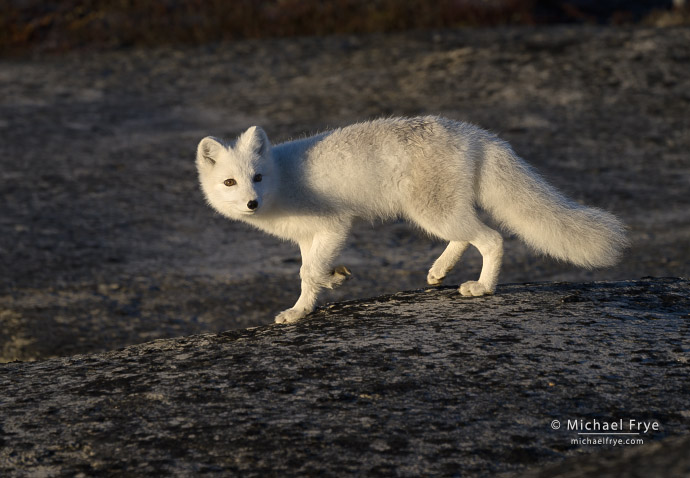
Arctic fox, Scoresby Sund, Greenland
Scoresby Sund, the area of east Greenland we visited on our Visionary Wild trip last month, is spectacularly beautiful. But I didn’t expect to see much wildlife there, because this region is actively hunted by the local Inuit people.
So I was pleasantly surprised by how much wildlife we actually saw, including musk oxen, Arctic hares, Arctic foxes, and polar bears.
(more…)
by Michael Frye | Sep 25, 2025 | Travels and Stories
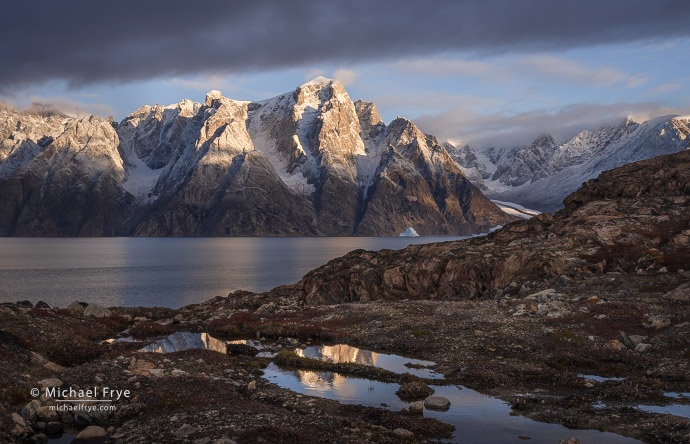
Pond, peaks, fiord, and glacier at sunrise, Scoresby Sund, Greenland
Claudia and I just got back from our trip to Greenland with Visionary Wild… and it was fantastic. This is such a beautiful part of the world, and we got to experience it with a wonderful group of people – our 16 lively and friendly participants, our fantastic ship’s crew, and my amazing co-instructors, Jerry Dodrill and Chris Linder.
Our Greenland expedition focused on Scoresby Sund, on the east coast. While the interior of Greenland is covered by the Greenland Ice Sheet, the second-largest body of ice on Earth (after the Antarctic Ice Sheet), Scoresby Sund is a land of sharp peaks and rocky fiords, with glaciers carving through the mountains and depositing icebergs into the sea. Scoresby Sund is considered the largest fiord system in the world, with many long, narrow channels, and mountains rising dramatically from the water to over 6,000 feet above sea level.
(more…)
by Michael Frye | Sep 1, 2025 | Light and Weather
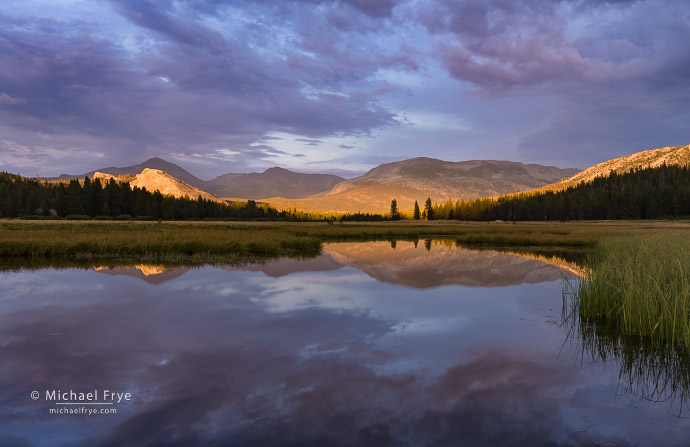
Sunset light, high country, Yosemite NP, California. I made this photo on Monday evening as the sun sank into a gap in the clouds and started to light the peaks.
Subtropical regions of the world experience monsoons every summer. The most famous monsoon occurs over the Indian subcontinent. But North America also gets a monsoon. It’s a complex weather process, but a primary force is the hot summer temperatures over land, which creates a localized low-pressure area, which in turn pulls moisture from the Gulf of California (and, to a lesser extent, the eastern Pacific and Gulf of Mexico) over the deserts of northern Mexico and the southwestern U.S. This monsoonal moisture brings thunderstorms to these regions, especially over higher terrain. While these thunderstorms are usually scattered widely, they can cause intense downpours over local areas, generating flash floods.
Here in central California we’re at the outer limits of the North American monsoon region. Monsoonal moisture typically reaches us for only a few brief stretches each summer, and often only generates showers and thunderstorms over higher elevations as that moisture gets pushed upward, cooling the air and causing the water vapor to condense into clouds and rain.
(more…)
by Michael Frye | Aug 25, 2025 | Digital Darkroom
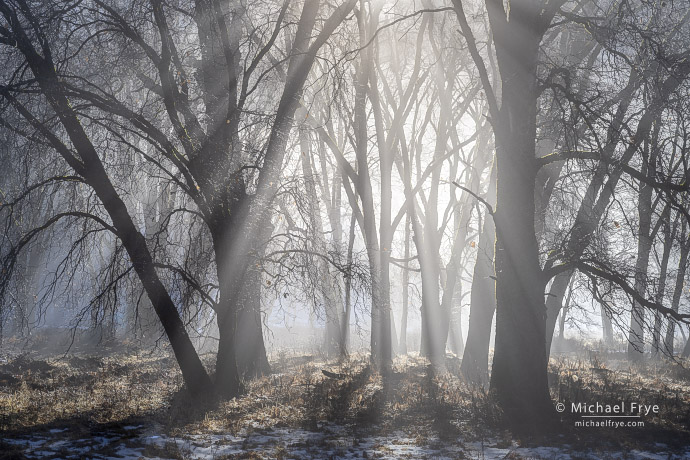
Oaks and mist, Yosemite NP, California. I love the light and fog in this scene, but couldn’t avoid including a distracting wire-mesh enclosure in the composition (see below).
Thanks to everyone who joined us for my Lightroom Webinar: Advanced Retouching on Saturday. It was an engaging, fun, and, I hope, educational session, and it was great to see so many familiar names among the attendees. I appreciate all the thoughtful questions, as they helped broaden the discussion and clarify many points.
One of the things we covered on Saturday was the pros and cons of AI-powered retouching in Lightroom – and how to work around the limitations. Generative Remove in Lightroom and Camera Raw, along with Generative Fill in Photoshop, have certainly made many retouching jobs a lot easier. But one thing that many people don’t realize is that these AI-powered tools can create low-resolution results. So when you remove an object with Generative Remove, that patch, that area where you replaced the object with AI-generated content, might look softer than its surroundings. That’s probably fine for posting an image online, because no one will notice that softness at a small viewing size. But it can be a significant problem when making prints.
(more…)
by Michael Frye | Aug 17, 2025 | Digital Darkroom, Photography Tips
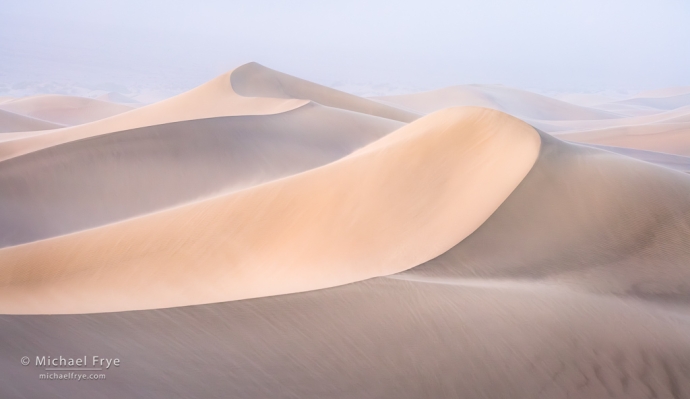
Dunes at sunrise in a sandstorm, Death Valley NP, California. During a dust storm, as you might expect, my sensor accumulated plenty of dust spots (see the next image below).
Removing dust spots from an image can be a tedious chore. Do you want to do that tiresome job twice? I certainly don’t – which is why I remove dust spots in Lightroom, rather than Photoshop.
There’s no way to do retouching in Photoshop in a completely flexible, non-destructive way that adapts to any further changes you make to the underlying layers. But when you remove a spot or object in Lightroom (or Camera Raw), the retouching will always adapt, no matter what you do to the image in the future. Even if you make a drastic change, like lightening the photo by two stops, making a big adjustment to the white balance, or converting it to black and white, the retouching in Lightroom will adapt and blend in seamlessly. And that means you’ll never, ever, have to do it again – which, for me, is a big advantage.
(more…)
by Michael Frye | Jul 27, 2025 | Advanced Techniques, Vision and Creativity
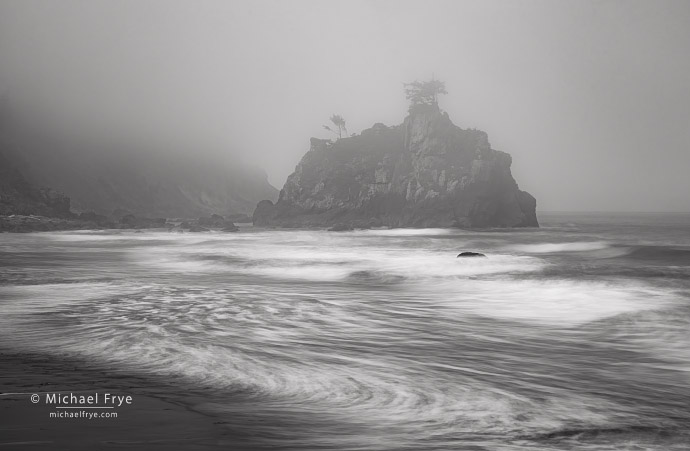
Sea stack and swirling waves, Northern California coast. 55mm, 3 seconds at f/16, ISO 200, ND filter. Timing was vitally important in making this photograph. I made 92 exposures with this exact same composition and camera settings, but only one had this zigzag wave.
Back in early June, before, during, and after our redwoods workshop in Northern California, we had many days with low fog along the coast. That’s somewhat unusual up there. It’s more typical to see the fog layer rise up a bit, where it looks like a low overcast at sea level, but if you can climb higher you might be able to get into the clouds, and into the fog.
That higher stratus deck usually works better for finding fog in redwood groves, since redwoods don’t grow at low elevations near the shore (there’s too much salt spray for them). But I love photographing low fog along the coast, with sea stacks and rock outcrops looming out of the mist. Fog is so common in these coastal areas that photographing these scenes in fog actually seems more characteristic, more typical, than photographing them on a sunny day, or even with a great sunset. I think of these shores as brooding and mysterious, so I like working with weather that enhances that mood.
(more…)
by Michael Frye | Jul 20, 2025 | Light and Weather
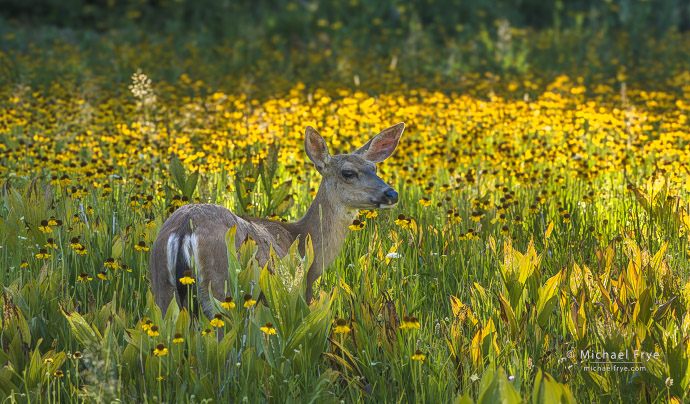
Mule deer doe and backlit wildflowers, Yosemite NP, California. 262mm, 1/500 sec. at f/16, ISO 1600.
It’s midsummer, which motivates Claudia and me to seek cooler and less-crowded spots in the Yosemite high country. And there are usually many flowers at those higher elevations this time of year, which gives us another incentive to go up there.
We spent a couple of afternoons recently in some colorful meadows. I loved the way the sunlight filtered through the trees next to these meadows, creating bands of light and dark through patches of flowers.
(more…)
by Michael Frye | Jul 13, 2025 | Night Photography
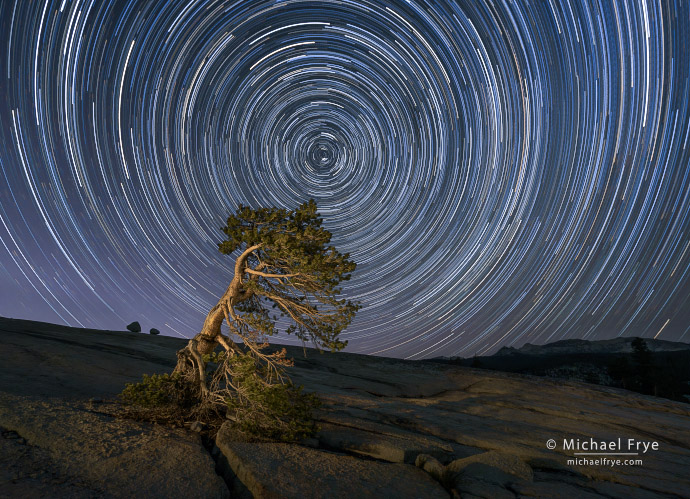
Star trails above a lodgepole pine, Yosemite NP, CA, USA
I think star-trail images have been somewhat neglected in recent years. Most night photographers today concentrate on capturing pinpoint stars and the Milky Way. The Milky Way is certainly beautiful, and modern digital sensors allow virtually anyone to capture the Milky Way without specialized equipment. Even phone cameras can do it. So all that is understandable.
With film you needed a star-tracker to capture the Milky Way, and it was virtually impossible to combine that Milky Way image with a stationary landscape in the foreground. But it was easy to capture star trails by just putting the camera on a tripod and leaving the shutter open for a long time. So star-trail photos became common long before Milky Way images filled up our Instagram feeds.
(more…)

















